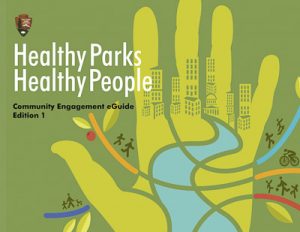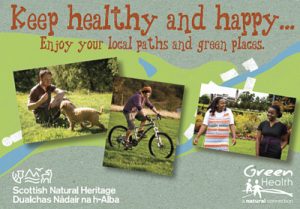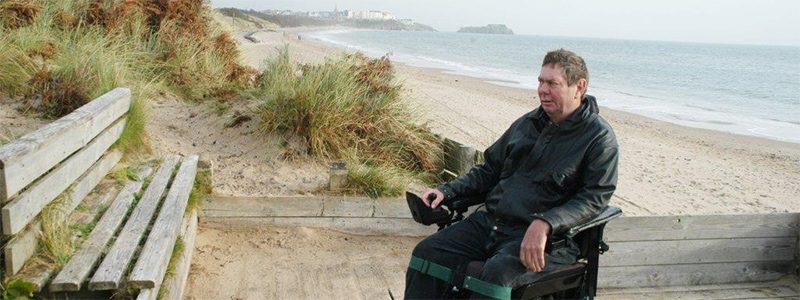By Bridget Finton
(in Volume 25)
Abstract
 At the IUCN World Parks Congress in Sydney in November 2014, the Improving Health and Well-Being theme enjoyed a high profile and featured many examples of how people’s health is benefitting from contact with nature. ‘Healthy Parks Healthy People’ (HPHP), an approach instigated in Australia by Parks Victoria, promotes the value of the environment to human health and is providing the impetus for Health and Environment alliances at various scales in countries such the USA, Canada and South Korea and in parts of Europe.
At the IUCN World Parks Congress in Sydney in November 2014, the Improving Health and Well-Being theme enjoyed a high profile and featured many examples of how people’s health is benefitting from contact with nature. ‘Healthy Parks Healthy People’ (HPHP), an approach instigated in Australia by Parks Victoria, promotes the value of the environment to human health and is providing the impetus for Health and Environment alliances at various scales in countries such the USA, Canada and South Korea and in parts of Europe.
In Scotland, physical activity and health inequalities are high on the agenda, with strong cross-sectoral policy recognition and partnerships to maximise health benefits from nature and landscapes in development that echo the HPHP approach. Scottish Natural Heritage (SNH) is playing a lead role in championing ‘Green Health’ – the achievement of health outcomes from use of green places, and is also working internationally on this topic, feeding in the experience being developed in Scotland to the EUROPARC Federation’s Health and Protected Areas working group and the IUCN Task Force on HPHP.
Introduction
The IUCN World Parks Congress is a once in a decade event, and the 6th international congress was held in Sydney Australia in November 2014 to explore ‘Parks, People, Planet: inspiring solutions’. Using Sydney’s Olympic Park as the venue, it was attended by more than 6,000 participants from over 170 countries, contained over 1,700 presentations and events and was structured around 8 themes. In Scotland, the development of policy, practice and partnerships to achieve greater use of the outdoors for improved health and well-being is gaining momentum and was presented as a case study by Scottish Natural Heritage (SNH) as part of collaborative input with Parks & Wildlife Finland into the congress Health theme.
The Health theme programme was co-ordinated by the US National Parks Service and Parks Victoria, one of Australia’s state parks agencies, and enjoyed a high profile within the Congress as a whole. The theme was notable for looking beyond the boundaries of Protected Areas, largely due to the leading work being done by Parks Victoria and their efforts to promote the Healthy Parks Healthy People approach. While the theme spanned the breadth of health and environment-related issues, the main focus was on how to get our increasingly urbanised and sedentary population to recognise, value and use the health-promoting resource that is our outdoors.
The Healthy Parks Healthy People approach
 Whilst public health priorities and environment-related issues differ around the world, today’s reality in the developed world is that non-communicable diseases now cause more deaths than all other diseases combined. Related to this, there is growing recognition of the role that physical activity can play in improving public health generally, and reducing the risk of developing conditions like heart disease, type 2 diabetes, some cancers, dementia and depression. ‘Green exercise’ – activities such as walking, cycling, outdoor learning and play, and conservation volunteering – offers a viable option for people to achieve recommended levels of physical activity through use of accessible greenspace. As well as providing a setting for activity that can improve physical health, evidence is growing of the mental health and social benefits that being in and being active in the outdoors can bring.
Whilst public health priorities and environment-related issues differ around the world, today’s reality in the developed world is that non-communicable diseases now cause more deaths than all other diseases combined. Related to this, there is growing recognition of the role that physical activity can play in improving public health generally, and reducing the risk of developing conditions like heart disease, type 2 diabetes, some cancers, dementia and depression. ‘Green exercise’ – activities such as walking, cycling, outdoor learning and play, and conservation volunteering – offers a viable option for people to achieve recommended levels of physical activity through use of accessible greenspace. As well as providing a setting for activity that can improve physical health, evidence is growing of the mental health and social benefits that being in and being active in the outdoors can bring.
The Healthy Parks Healthy People (HPHP) concept was first introduced by Parks Victoria and seeks to reinforce and encourage the connections between a healthy environment and a healthy society. Since 2000, Parks Victoria has been the lead advocate for HPHP, commissioning Deakin University, Melbourne, to undertake literature reviews of the evidence in 2002 and 2008, and hosting an international HPHP Congress in Melbourne in 2010. To illustrate Parks Victoria’s commitment to this agenda, the Healthy Parks Healthy People trademark is used on Rangers’ uniforms and vehicle livery.
At the World Parks Congress it was encouraging to see how the HPHP approach is being adopted in, for example, South Korea (‘Healthy Parks Happy People’), Singapore, Canada (‘Healthy by Nature’) and the USA, to name just a few.
One case study presented in Sydney that particularly impressed was in the Bay Area of San Francisco where the HPHP initiative promotes free access to, and healthy use of, the 37 natural and cultural locations – known collectively as the Golden Gate National Recreation Area. The initiative, which includes programmes of events and ‘Park Prescriptions’, involves 50 parks, health and community agencies and has been taken up by all 9 Bay Area counties (total resident population of 7.4 mill).
The Health theme showcased a number of examples of how the environment and health sectors are working together to deliver public health benefits from the use of parks and protected areas. The HPHP approach adopts a broad definition of ‘parks’, ranging from urban greenspace to national parks, meaning that the approach is applicable whether public access to the outdoors is provided mainly on publicly owned lands, by rights of way networks or through broad-based open access arrangements.
Some common messages highlighted in the World Parks Congress Health theme:
- re-connecting to nature is a valuable nature-based solution to the global challenge of poor health
- environment and health sectors need to learn each others’ languages
- sport, transport, and commercial sectors e.g. tourism and health insurance also have roles to play
- ‘life stories’ are as powerful as empirical evidence
- accessible greenspace close to where people live is vital in increasing our daily physical activity and tackling health inequalities
- young people need to be supported to re-connect with nature so as to establish healthy life-long behaviours
 Has the HPHP approach reached Europe?
Has the HPHP approach reached Europe?
The HPHP brand is not widely used in Europe, as yet – in part because it doesn’t always directly translate from English in the same catchy way. One notable exception is in Finland, where the government environment agency – Metsahallitus Parks and Wildlife Finland – has produced its Healthy Parks Healthy People Strategy and has a number of active initiatives which link target groups, such as immigrants experiencing social exclusion, to parks resources. Nonetheless, in other European countries there are numerous examples of projects and initiatives that apply the same principles of HPHP in their promotion of ‘new’ healthy activities such as ‘disc golf’ and ‘sea walking’ and in partnership work with sectors including sport, tourism and complementary medicine to promote health benefits. A number of case studies which show the range of activity being progressed in this topic area have been collated by the EUROPARC Federation’s Health & Protected Areas working group and published on the EUROPARC website.
What’s happening in Scotland?
In Scotland, the approach being developed is consistent with the HPHP principles although the brand is not in common usage. A key step has been achieving a high-level recognition of the value of the environment which has, in turn, supported the development of a cross-sectoral policy framework linking environment and health. Coupled with a fantastic range of outdoor resources, progressive access legislation, and some innovative programmes which seek to maximize the potential of our outdoors resource for health outcomes, we have a solid foundation on which to build.
Important policy connections have been made in which health features in environment policy, environment features in health policy, and the links between environment and health are also recognised in many other public policy areas including planning, transport and education. Examples include the 2030 Vision for Active Travel in Scotland which aims to deliver health outcomes, the steer in the Curriculum for Excellence to take learning outdoors, the call in the National Physical Activity Implementation Plan for increased use of Scotland’s outdoors and the Biodiversity Strategy’s reference to a ‘natural health service’. This policy development flows from the National Performance Framework which underpins planning by the public sector in Scotland, and performance indicators – including ‘Increased public use of the outdoors’ – are used to monitor progress in the delivery of the Outcomes and Targets. At the local level, these policy priorities are reflected in the work of Community Planning Partnerships with their strong focus on tackling physical activity and health inequalities. To back up integrated policies, key initiatives such as the Central Scotland Green Network and the National Walking and Cycling Network both place significant emphasis on the delivery of health outcomes through improving the extent and quality of outdoor access infrastructure.
Ambition into action
Having a robust policy framework stands Scotland in good stead, but doesn’t automatically lead to implementation on the scale envisaged. A range of challenges need to be overcome including the common issues of environment-based projects often being dependent on key motivated personnel and vulnerable to short-term funding, and the NHS not having the same kind of tradition of cross-sector partnership working as environmental organisations. That said, there are many good projects and initiatives linking the environment and health benefits such as Health Walks groups (Paths for All) and Green Gyms (TCV).
Successful implementation of policy aims – in a way that maximises the flow of health benefits from nature and its contribution to improving the nation’s health – requires changes to existing cultures and practices, as well as the development of new partnerships and innovative approaches which lead to adoption into mainstream practice. Some current examples of initiatives in Scotland include:
In response to healthcare practitioners’ frustration that, whilst recognising the potential benefits of green exercise for a range of patients, they had poor awareness of local opportunities and no readily available information to provide to relevant patients, a pilot project in Dundee has connected the city council Ranger Service with a number of health centres. In consultation with staff and patients, the Ranger Service developed a simple message and a Green Exercise gateway page on the council’s website so that healthcare staff could signpost people to this ‘one-stop-shop’ for information on what paths, places and activity programmes are available to them.
In Lanarkshire, following on from the Area Health Board’s establishment of a social prescribing initiative which includes the promotion of green exercise resources, a ‘Greenspace, Health & Well-being Partnership’ has been set up. This is enabling the health board, local authorities, leisure trusts, environmental organisations and voluntary bodies to co-ordinate the planning and delivery of infrastructure and information. By agreeing joint aims and improving communication between partners, value is being added to existing programmes and new projects are being stimulated, including how to make information on green exercise assets easier to access by health sector staff.
At national level the Green Exercise Partnership, which brings together SNH, Forestry Commission Scotland and NHS Health Scotland, is working to deliver a shared aim of greater use of the outdoors for better health and quality of life. This strategic partnership is the leading advocate for green exercise, and, as part of this, is also co-ordinating the NHS Greenspace Demonstration project with extra funds from the Scottish Government. Working with Area Health Boards, the focus of this collaborative work is on demonstrating the health benefits that flow from positive investment in, and management of the NHS estate – literally the greenspace around hospitals and healthcare centres that can be used by patients, staff, visitors and the local community. The aim of the project is to show how healthy activity and health outcomes are available right on the doorstep of these NHS facilities, and to influence health board policy and practice so that this resource is managed for informal recreational use, health promotion and clinical interventions.
Moving forward
Physical activity is high on governments’ agendas. It has been cited as ‘the best buy in public health’ and offers a nearly universally accessible contribution to better health. Green exercise – and the broad range of health benefits to be gained from being in and being active in the outdoors – can contribute to this agenda.
In Scotland, progress is being made through policy, practice and partnerships, but it’s a big ‘ask’, to effect both a shift in public behavior that makes activity out of doors – active travel, contact with nature, a ‘walk in the park’ – part of ‘normal’ daily life, and a cultural shift in the health sector to embrace green exercise as part of core business in prevention, treatment and care of ill-health.
The development of integrated policy is helping environment, health, and other relevant sectors to work together, and there is a greater recognition of the need for preventative spend – both within the health sector and in guiding investment in green infrastructure. With a clear current emphasis on tackling health inequalities, the environment has huge potential to contribute to a Healthier Scotland – and we’re making progress, progress which can learn and benefit from the global approach which is Healthy Parks Healthy People.
SNH has a lead role to play in championing this agenda, which we’re starting to refer to as ‘Green Health’, and the connections being made in Scotland between environment and health are providing us with experience we can share in the development of wider work. SNH is feeding into the EUROPARC Federation’s Health and Protected Areas working group on which is promoting the principles of the Healthy Parks Healthy People approach through the Federation’s network, and we are also providing input into the IUCN’s Healthy Parks Healthy People Task Force. 2015 will see more resources made available with the publication of the IUCN’s Best Practice Guidelines (the first in this series to look at protected areas and beyond ) to promote and support the adoption of the Healthy Parks Healthy People approach, and Deakin University’s updated literature review of the health benefits of contact with nature.
Useful links:
www.hphpcentral.com – for information about Healthy Parks Healthy People
www.europarc.org/nature/health-protected-areas/ – for European case studies
www.snh.gov.uk/land-and-sea/managing-recreation-and-access/healthier-scotland/ – for information on SNH’s green health programme
It is my opinion that conservation and park management can save more lives, promote more health and deal with more ill health than the public health sector can achieve” – Professor Jonathan Patz – Director of the Global Health Institute, University of Wisconsin, at the World Parks Congress 2014
